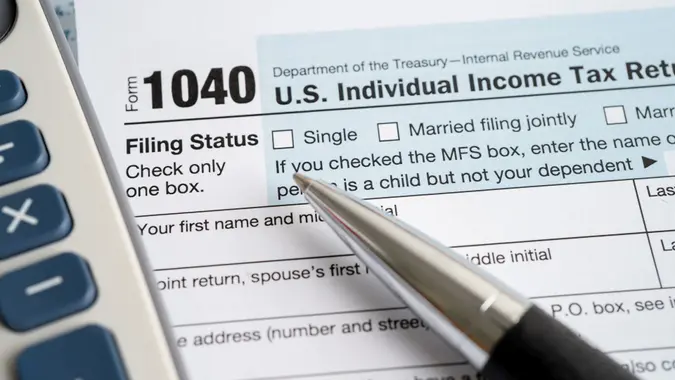School Supply Donations Are Tax Deductible: Where To Donate and What To Give

Commitment to Our Readers
GOBankingRates' editorial team is committed to bringing you unbiased reviews and information. We use data-driven methodologies to evaluate financial products and services - our reviews and ratings are not influenced by advertisers. You can read more about our editorial guidelines and our products and services review methodology.

20 Years
Helping You Live Richer

Reviewed
by Experts

Trusted by
Millions of Readers
Buying school supplies is a fun rite of summer for most American families, but for others, it’s just another money stress. That’s especially true now amid the highest inflation rate in more than four decades.
As Forbes recently reported, some parents struggle to purchase essential school supplies for their kids every year. In many cases, students might begin the school year without enough school supplies, leaving teachers to fill the gap.
According to a 2021 survey by the National Center for Education Statistics, 94% of public school teachers paid for school supplies with their own money. A separate survey by Adoptaclassroom.org found that teachers spent an average of $750 of their own money to purchase supplies for their classrooms during the 2020-21 school year.
One way to help ease the burden for both teachers and struggling families is to donate school supplies. Depending on the organization and the type of donation, you might also be able to deduct the donation from your taxes.
The IRS lets you claim a deduction for the donations you make to qualified organizations. This includes not only charities, but also school district programs that don’t operate at a profit and are solely supported by state and local governments, according to Intuit TurboTax. Just be sure to research the organization beforehand to make sure donations are tax deductible.
The amount you can deduct is equal to the value of all cash and property you donate to the organizations or school district programs. Federal tax law lets you use any “reasonable valuation method” for most property contributions, Intuit TurboTax noted. For example, if you donate school supplies, you can check costs for comparable school supplies at local retailers to find a valuation.
If you’re thinking about donating, the most needed items are art supplies, backpacks, calculators, laptops and tablets, notebooks, writing instruments and sports equipment.
Here are some of the top places you can donate supplies, according to Forbes:
- Local school supply drives: These often take place just before school starts and are advertised in local libraries, retailers, community organizations and churches.
- Your child’s school: Contact your child’s teacher(s) to find out what is most needed.
- Adoptaclassroom.org: This is a non-profit fundraising platform used by teachers to raise money for needed supplies. You can donate to a specific school, teacher or spotlight fund.
- Compudopt: Here is another nonprofit that collects, refurbishes and distributes gently used computers, monitors, keyboards and other equipment to schoolchildren with limited financial resources.
- Computers with Causes: This organization provides free refurbished computers to low-income families and foster children.
- Kids In Need Foundation: This is yet another nonprofit organization that provides school supplies to students and teachers in underserved schools.
- Leveling the Playing Field: This organization collects gently used sports equipment and distributes it to schools and other programs that serve youth with limited resources. You can either donate equipment or make a financial donation.
- Operation Backpack: This is a Volunteers of America program that provides backpacks filled with school supplies to students in need. To help out, you can make a monetary donation to help cover costs.
- United Way: The types of school supplies United Way accepts depends on students’ needs in individual communities. Contact your local United Way organization to find out what is needed the most, and how to donate.
 Written by
Written by  Edited by
Edited by 

























